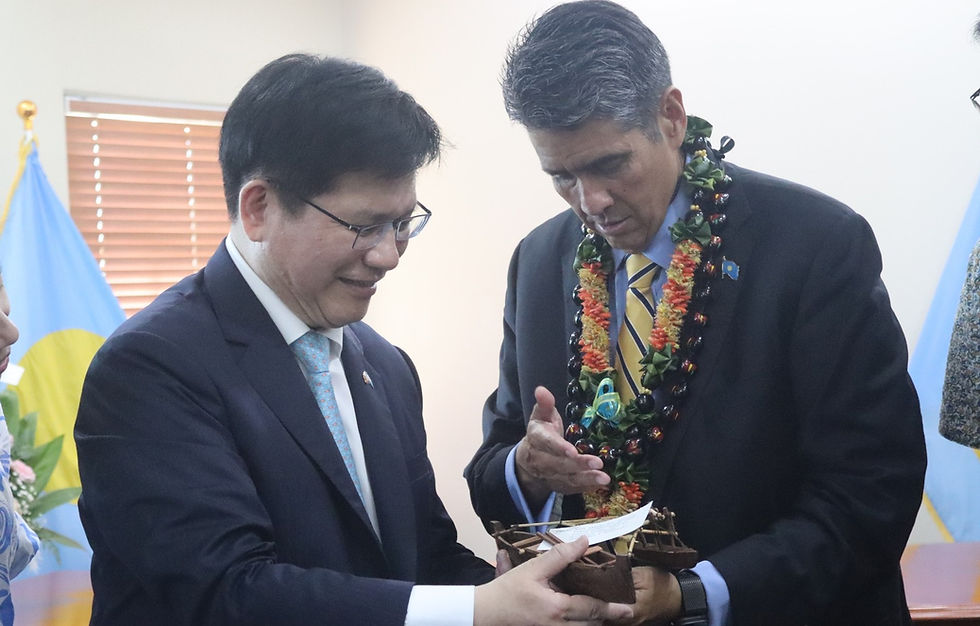Reconnecting with the sea tradition: Marshallese rekindling interest in outrigger sailing
- By Geoff Goodman
- Nov 15, 2020
- 3 min read

The revival of Marshallese maritime culture is happening at a crucial point in history—a time when it could easily be lost along with other traditions. It has been in danger of not being passed down due to colonial cultural upheaval both in a change in lifestyle and from foreign technologies such as the outboard engine.
However, a rebirth of local interest, sailing competitions and Marshallese culture organizations like Waan Aelõñ in Majel have rekindled interest in outrigger sailing and the hope that it will carry on.
The Marshallese are Micronesians who are part of a larger collection of cultures connected by a language family and shared technologies. That larger group is often called the Austronesian people. These cultures were able to colonize and expand across an enormous sector of the Earth’s surface, from Taiwan to New Zealand, and Madagascar to Hawaii. They were also able to do this thousands of years before the Mongolian, European, Persian—or any other—empire of such a scale because of a deceptively simple piece of technology that did not occur in other cultures even well into modern times.
That technology is a watercraft featuring a second, stabilizing hull connected to the first by lateral beams called an outrigger canoe. The second hull allows the primary hull to be longer and thinner, and thus faster and more efficient, as it does not need to stabilize itself. It also allows for a lot more boat for the amount of building material, often at a premium on remote islands.
Marshallese designs of outrigger canoes (also referred to as simply canoes) allowed the Marshallese the ability to travel as far east as Hawaii and as far west as Pohnpei in the Federated States of Micronesia—a span of 5000 kilometers. Technological innovations and improvements that the locals implemented include asymmetric hulls and double-ended hulls. The asymmetric hull, the outside of which was flat and the inside round, provides the craft with a larger degree of angles that it can sail with the wind. Having back and front bows means that mariners can use either end as the front of the canoe, switching the back for the front and vice-versa very quickly and easily.
A special sail design allows the sail too to be placed facing either direction, optimizing use of wind speed and direction.
There are three kinds of canoes that the Marshallese use. They are the Walap, a large vessel up to 100 feet in length, the medium-sized Tipnol, and the 10-15 foot Korkor. The Walap are scarce now but were designed to carry up to 100 people with food and water for up to several months. The smallest, the korkor is still common and mostly used for fishing and transport within atoll lagoons.
Traditionally canoes are all made from breadfruit trees and held together with coconut sennit. Materials and techniques have also been integrated with modern materials and designs to make building and maintenance more attainable for all.
Also entwined with Marshallese culture and oral tradition are the navigational techniques used to travel those thousands of miles across the Pacific. This was done thousands of years before GPS and involved an astounding interplay of seafaring knowledge and techniques. Navigators can read in waves how distant islands affect swells to a degree that wave buoys cannot, in addition to piloting by the stars. These techniques have not been able to be replicated by outsiders.
Outrigger canoes are so enmeshed with Marshallese life that their components are named after essential aspects of it. The booms that frame the sail with the mast are named for husband and wife, as are the two connected hulls, while other parts of the canoe also represent familial relationships. A platform atop the beams spanning the hulls is a Menajij, or “eyes of god.” Jouj, or “kindness” is also the word for the bottom of the hull. The survival of these traditions is paramount in the survival of their people.
Subscribe to
our digital
monthly edition







